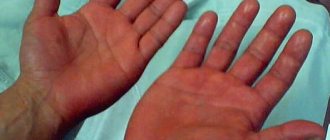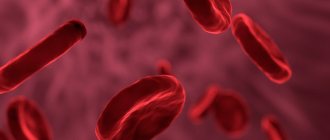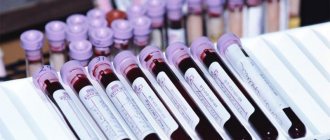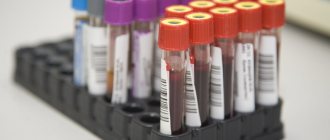Author:
- Yanova Natalya Yurievna
otorhinolaryngologist of the highest qualification category
3.50 (Votes: 6)
ASLO are antibodies against a special type of microorganism - streptococci.
When a person experiences any type of streptococcal infection, his body produces antibodies called antistreptolysin O or ASLO.
This indicator is a signal of the presence of group A β-hemolytic streptococcus (GABHS) antigen in the body. GABHS secretes the enzyme streptolysin, which is toxic to the tissues of the heart, joints, kidneys and can cause the destruction of red blood cells, a rise in temperature, and the appearance of a rash. In response to this enzyme, the body secretes antibodies - antistreptolysin O, which eliminate the waste products of bacteria, but they are powerless against streptococcus itself. Therefore, adequate and timely treatment is necessary. If the level of ASLO in the blood is elevated, this indicates infection with GABHS, which can lead to serious complications and affect the joints, heart, kidneys, and nervous system.
If a blood test does not reveal this antigen in a person or it is within normal limits, then there is no cause for concern. In addition, this is not only proof of the absence of infection, but also that the person has not had to deal with streptococcus during the last 6 months.
| Age (years) | Antistreptolysin is normal. Maximum permissible limit |
| up to 7 | 100 units/ml |
| 7-14 | 250 units/ml |
| From 14 and adults | 200 units/ml |
When making a diagnosis, it is worth considering the timing of the increase in the number of antibodies in the blood test:
- The increase in ASLO begins at 3-5 weeks of infection;
- After reaching the maximum level (at week 6), the level decreases;
- High results of ASLO can last from 6 months to a year;
- If measures are not taken in time at a high concentration of antistreptolysin, this can lead to complications in the form of rheumatic fever, and stabilization of indicators will occur after 4-8 months;
- If within 6 months. the ASLO level remains high, then the patient should expect a relapse of the disease.
Indications for blood testing for antistreptolysin O
For diseases such as:
- Scarlet fever;
- Erysipelas;
- Tonsillitis (tonsillitis);
- Pyoderma is a purulent lesion of the skin;
- Rheumatic fever;
- Glomerulonephritis - damage to the glomeruli...
Even a year after you have been cured, you must be retested for antistreptolysin - O. This is done to make a more accurate diagnosis, as well as to exclude the possibility of relapse.
A blood test for ASLO should be taken for: arthritis, arthrosis, back pain, pharyngitis, sore throat, laryngitis, tracheitis, pharyngitis, scarlet fever, erysipelas, rheumatism, glomerulonephritis, myocarditis...
Reasons for increasing ASLO
Among the factors in the development of the disorder are the following:
Acute tonsillitis
Oropharynx lesions by pyogenic flora are the most common reason why ASLO is elevated in the blood. It occurs in both sexes, regardless of age. Another name for the disorder is sore throat.
The critical phase is characterized by a dangerous course. Complications from the heart and respiratory system are possible.
Attention:
If treatment is not timely, the disease enters the chronic stage and cannot be completely cured.
Acute pharyngitis
Inflammatory damage to the velopharyngeal arch occurs as a cause of increased antistreptolysin O no less often. The process is accompanied by a lot of extremely uncomfortable symptoms.
Symptoms include: severe, raw pain in the throat, disturbances in the swallowing process, choking, swelling, cough without producing a large amount of sputum, increased body temperature and, accordingly, signs of general intoxication of the body.
Attention:
It is urgent to begin treatment, since the process is prone to early chronicity.
Glomerulonephritis
Autoimmune inflammation. In this case, it involves the renal structures. It almost always has an extremely unfavorable course.
Accompanied by a gradual or rapid change in the function of the paired filtering organ. Dysuric disorders are also observed.
An increase in the frequency of urination, and then a drop in the amount of urine per day, a change in the shade of the discharge, and other phenomena. Without quality therapy, kidney failure cannot be avoided.
Rheumatoid arthritis
Another form of an autoimmune pathological process. As the name suggests, this is a joint disorder.
Usually the first symptoms are severe pain in large structures of the musculoskeletal system. Small ones are left “for later”, and a complex lesion occurs.
Without therapy, there is a high probability of disability as a result of loss of motor activity of the limb that has undergone changes.
Rheumatism
In the vast majority of cases, it is characterized by autoimmune damage to the myocardium and is accompanied by an increase in the concentration of antistreptolysin in the blood. It poses a great danger to life; without therapy, it is practically impossible to avoid chronic heart failure.
Systematic maintenance treatment is required under the supervision of a specialist of the same name. Rheumatologist.
Skin variants of streptococcal infection
Observed as a primary or secondary lesion. Externally, the process looks like a single focus of ulcerative changes in the dermis. With the formation of a defect, an area of tissue destruction.
At the initial stage, a red spot of small diameter (up to several centimeters) appears. Then new ones may arise, merging into a single focus.
Ultimately, rough scarring is observed with the formation of a large crust (eschar).
Without quality treatment, a cosmetic defect is likely to develop or the process will further expand. The name of the disorder is streptoderma. It is possible to develop multiple rashes without tissue ulceration.
Lesions of the central nervous system
It is relatively rare. Usually due to a weakened immune system. It manifests itself as meningitis, an inflammatory lesion of the meninges.
The reasons for the increase in antistreptolysin-O in adults are mainly associated with previously acquired otolaryngological processes; spontaneous damage without any symptoms is less common. The so-called carrier state, which a person may not even be aware of.
Preparing for a visit to the laboratory
To obtain the most accurate results, donating blood for ASLO requires preparation:
- Last meal 8 hours before;
- After undergoing antimicrobial or antibacterial therapy, at least 3 weeks must pass;
- Limit medication intake on the eve of blood donation;
- Within 24 hours, reduce sweet, salty, spicy, flour and meat from the diet;
- Stop drinking alcohol within 7 days
- To monitor the dynamics of the development of the disease, blood donation for ASLO is carried out 2 times with a break of 7 days, that is, 1 time per week.
Interpretation of results
For children under 14 years of age, reference values are lower than for older patients. The production of ASL-O in the body begins 7-14 days after infection. After 1-1.5 months, its concentration reaches its maximum value. Antibodies can be detected in the blood for some time after recovery.
A low level of antibodies or their absence makes it possible to exclude with a high degree of probability a recent infection with streptococci. To confirm, the analysis can be repeated at intervals of about two weeks. If the result is negative again, there is most likely no infection. Exceptions to this rule are rare, but still occur. In rare cases, in patients with complications after infection, ASL-O levels remain within reference values.
Exceeding the norm by 4 or more times, as well as an increase in indicators, indicate a streptococcal infection that the patient recently suffered. A decrease in antibody concentration indicates recovery. The number of antibodies can be used to judge how long ago the infection was suffered. It is impossible to judge the likelihood of complications developing, as well as their possible severity, using ASL-O indicators alone. The test results can confirm the diagnosis in patients with symptoms of glomerulonephritis or rheumatic fever. A number of factors need to be taken into account when interpreting the results. Antibody levels may increase in patients with reactive arthritis, liver pathologies and hypercholesterolemia. When taking a number of antibacterial drugs, corticosteroids, as well as in patients with nephrotic syndrome, false negative results may be obtained. This test is not used to diagnose acute infection, since ASL-O is detected no earlier than 1-2 weeks after infection.
Treatment
The origin of the inflammatory process plays an important role in the choice of treatment. If you should resort to antibacterial therapy for angina, then in other cases this treatment method may not be effective. An ASLO blood test helps avoid unnecessary antibiotic use and complications.
Additional studies to make a correct diagnosis and exclude complications are:
- Oropharyngeal smear or streptate test;
- Ultrasound, ECG,
- Blood and urine analysis.
Based on the data obtained, a group of medications and their dosage are selected. The individual characteristics of the body and the presence of allergies in the patient are also taken into account.
In the conditions of “ENT Clinic No. 1”, highly qualified specialists will examine ENT organs using endoscopic equipment. They will carry out the necessary diagnostics: a smear from the pharyngeal mucosa, a streptate test, a clinical blood test and an ASLO test, a urine test, an ECG. They will select adequate treatment and prescribe physiotherapeutic therapy (USOL and laser therapy), which will maximize the patient’s condition and speed up recovery.
References
- Atlas of medical microbiology, virology and immunology / ed. A.A. Vorobyova, A.S. Bykova. - M.: Medical Information Agency, 2003. - P. 37.
- Prevention of streptococcal (group A) infections. Federal clinical guidelines, 2013 - 43 p.
- Clinical recommendations (treatment protocol) for providing medical care to children with tonsillitis (acute streptococcal tonsillitis), 2015. - 29 p.
- Levanovich, V.V., Bannova, S.L., Timchenko, V.N. Evolution of streptococcal infection. Guide for doctors. - SpetsLit., 2015. - 495 p.
- Kanwal, S., Vaitla, P. Streptococcus Pyogenes. — In: StatPearls, 2021.
- Lab Tests Online: website. Antistreptolysin O (ASO), 2021. - URL: https://labtestsonline.org/tests/antistreptolysin-o-aso.
How to achieve lasting remission
In order to forget about exacerbations of rheumatoid arthritis, you need to:
- Healthy food;
- move more, do exercise therapy, swim, walk;
- get rid of stress, overload at work and at home, heavy physical work;
- no smoking;
- promptly identify and treat hormonal disorders;
- regularly carry out courses of maintenance treatment prescribed by your doctor.
Rheumatoid arthritis in women is treated at any stage. The specialists of the Moscow Paramita clinic know this well.
Literature:
- Nasonov EL, Karateev DE, Balabanova RM. Rheumatoid arthritis. In the book: Rheumatology. National leadership. Ed. E. L. Nasonova, V. A. Nasonova. Moscow: GEOTAR-Media; 2008. pp. 290–331.
- Folomeeva O. M., Galushko E. A., Erdes Sh. F. Prevalence of rheumatic diseases in adult populations of Russia and the USA. Scientific and practical rheumatology. 2008;46(4):4-13. DOI:10.14412/1995-4484-2008-529.
- Leandro G, Mangia A, Hui J, et al. Relationship between steatosis, inflammation, and fibrosis in chronic hepatitis C: a meta-analysis of individual patient data. Gastroenterology 2006;130(6):1636-42.
- Rubbia-Brandt L, Quadri R, Abid K, et al. Hepatocyte steatosis is a cytopathic effect of hepatitis C virus genotype 3. J Hepatol 2000;33(1):106-15.
- Hezode C, Roudot-Thoraval F, et al. Different mechanisms of steatosis in hepatitis C virus genotypes 1 and 3 infections. J Viral Hepat 2004;11(5):455-8.
Themes
Joints, Pain, Treatment without surgery Date of publication: 04/14/2020 Date of update: 03/12/2021
Reader rating
Rating: 4.67 / 5 (3)
Stages
Any form of arthritis has serious complications, so you should not delay treatment.
See how easily the disease can be cured in 10-12 sessions.
There are 4 clinical stages of the development of rheumatoid arthritis in women:
- Initial
– lasts for 6 months, the first signs are somewhat erased, but remain constant; sometimes there is an acute onset; - Early
– the development of pathology in the first year of the disease, the symptoms appear clearly. - Expanded
– the first two years of the disease, the signs are bright, the course is progressive, possible impairment of joint mobility. - Neglected
– more than two years, symptoms of joint deformation and persistent impairment of limb function appear, which becomes a cause of disability.
From stage to stage, there is a clear tendency for arthritis to progress in the absence of treatment. Therefore, it is very important to promptly identify the symptoms of rheumatoid arthritis in women and immediately begin treatment.







